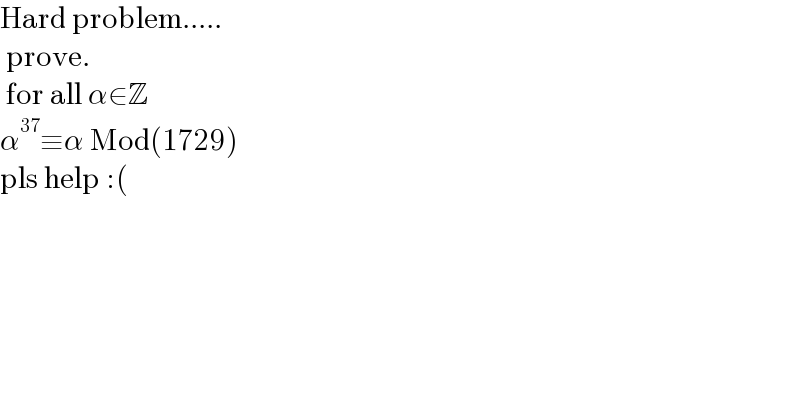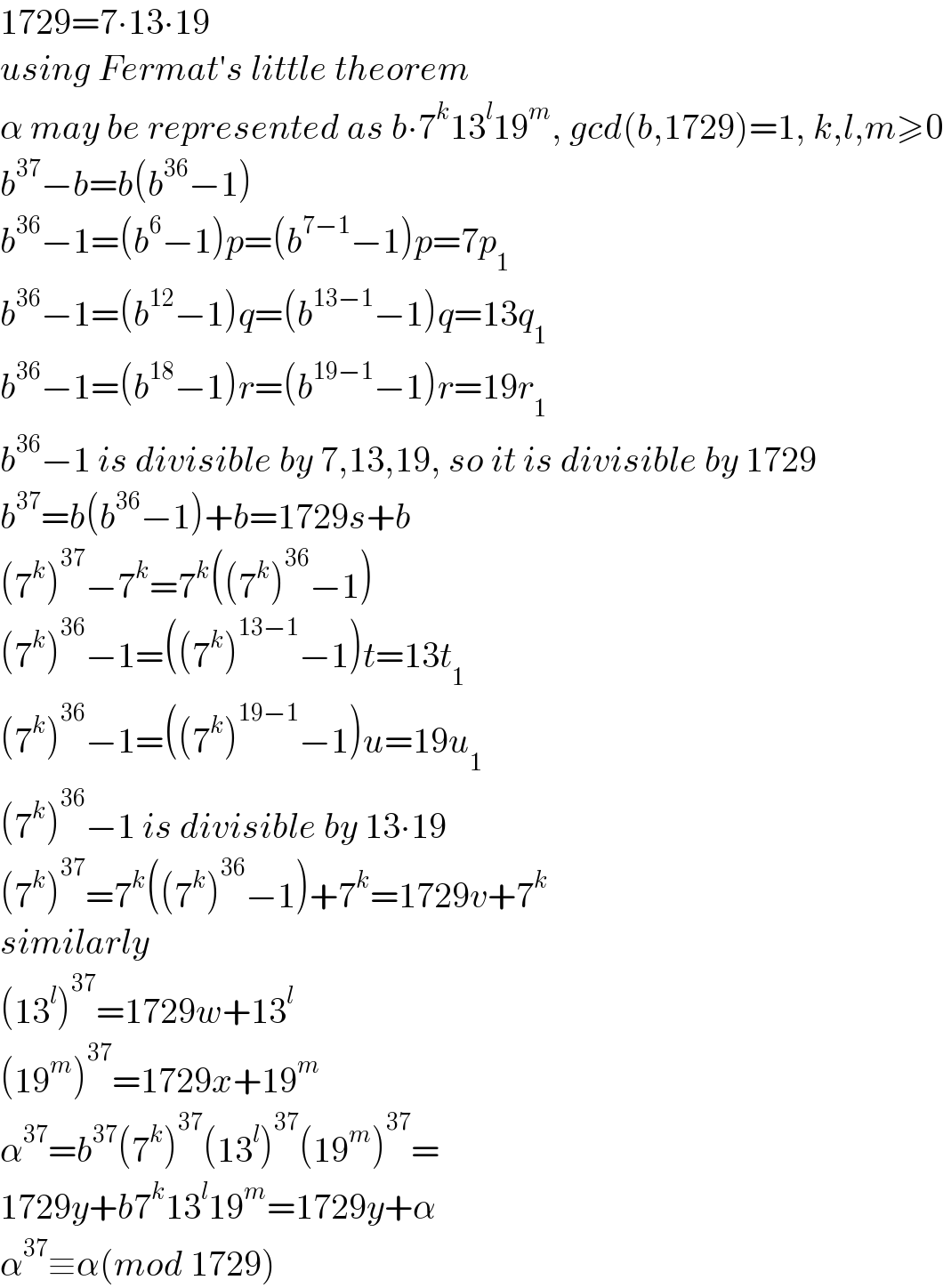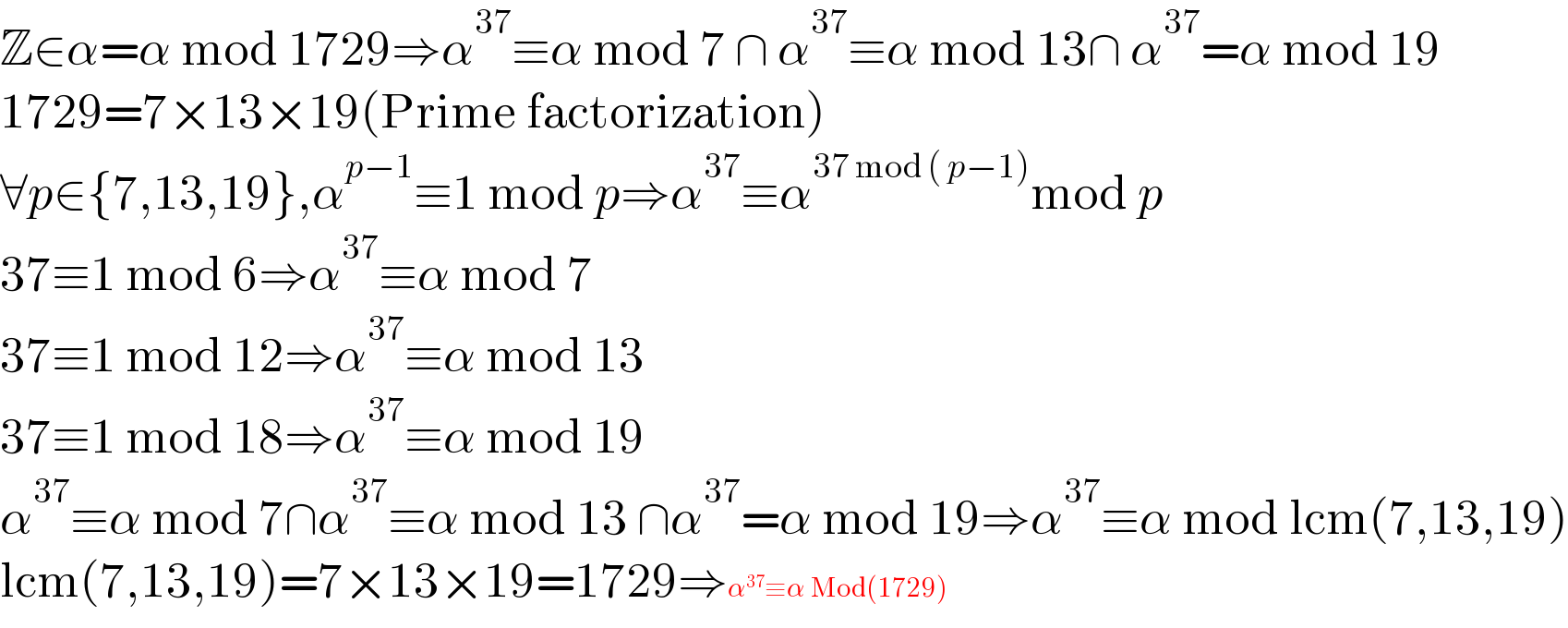
Question Number 218400 by SdC355 last updated on 09/Apr/25

$$\mathrm{Hard}\:\mathrm{problem}..... \\ $$$$\:\mathrm{prove}. \\ $$$$\:\mathrm{for}\:\mathrm{all}\:\alpha\in\mathbb{Z} \\ $$$$\alpha^{\mathrm{37}} \equiv\alpha\:\mathrm{Mod}\left(\mathrm{1729}\right) \\ $$$$\mathrm{pls}\:\mathrm{help}\::\left(\right. \\ $$
Answered by Nicholas666 last updated on 09/Apr/25

$$ \\ $$
Answered by Nicholas666 last updated on 09/Apr/25

$$ \\ $$
Answered by vnm last updated on 09/Apr/25

$$\mathrm{1729}=\mathrm{7}\centerdot\mathrm{13}\centerdot\mathrm{19} \\ $$$${using}\:{Fermat}'{s}\:{little}\:{theorem} \\ $$$$\alpha\:{may}\:{be}\:{represented}\:{as}\:{b}\centerdot\mathrm{7}^{{k}} \mathrm{13}^{{l}} \mathrm{19}^{{m}} ,\:{gcd}\left({b},\mathrm{1729}\right)=\mathrm{1},\:{k},{l},{m}\geqslant\mathrm{0} \\ $$$${b}^{\mathrm{37}} −{b}={b}\left({b}^{\mathrm{36}} −\mathrm{1}\right) \\ $$$${b}^{\mathrm{36}} −\mathrm{1}=\left({b}^{\mathrm{6}} −\mathrm{1}\right){p}=\left({b}^{\mathrm{7}−\mathrm{1}} −\mathrm{1}\right){p}=\mathrm{7}{p}_{\mathrm{1}} \\ $$$${b}^{\mathrm{36}} −\mathrm{1}=\left({b}^{\mathrm{12}} −\mathrm{1}\right){q}=\left({b}^{\mathrm{13}−\mathrm{1}} −\mathrm{1}\right){q}=\mathrm{13}{q}_{\mathrm{1}} \\ $$$${b}^{\mathrm{36}} −\mathrm{1}=\left({b}^{\mathrm{18}} −\mathrm{1}\right){r}=\left({b}^{\mathrm{19}−\mathrm{1}} −\mathrm{1}\right){r}=\mathrm{19}{r}_{\mathrm{1}} \\ $$$${b}^{\mathrm{36}} −\mathrm{1}\:{is}\:{divisible}\:{by}\:\mathrm{7},\mathrm{13},\mathrm{19},\:{so}\:{it}\:{is}\:{divisible}\:{by}\:\mathrm{1729} \\ $$$${b}^{\mathrm{37}} ={b}\left({b}^{\mathrm{36}} −\mathrm{1}\right)+{b}=\mathrm{1729}{s}+{b} \\ $$$$\left(\mathrm{7}^{{k}} \right)^{\mathrm{37}} −\mathrm{7}^{{k}} =\mathrm{7}^{{k}} \left(\left(\mathrm{7}^{{k}} \right)^{\mathrm{36}} −\mathrm{1}\right) \\ $$$$\left(\mathrm{7}^{{k}} \right)^{\mathrm{36}} −\mathrm{1}=\left(\left(\mathrm{7}^{{k}} \right)^{\mathrm{13}−\mathrm{1}} −\mathrm{1}\right){t}=\mathrm{13}{t}_{\mathrm{1}} \\ $$$$\left(\mathrm{7}^{{k}} \right)^{\mathrm{36}} −\mathrm{1}=\left(\left(\mathrm{7}^{{k}} \right)^{\mathrm{19}−\mathrm{1}} −\mathrm{1}\right){u}=\mathrm{19}{u}_{\mathrm{1}} \\ $$$$\left(\mathrm{7}^{{k}} \right)^{\mathrm{36}} −\mathrm{1}\:{is}\:{divisible}\:{by}\:\mathrm{13}\centerdot\mathrm{19} \\ $$$$\left(\mathrm{7}^{{k}} \right)^{\mathrm{37}} =\mathrm{7}^{{k}} \left(\left(\mathrm{7}^{{k}} \right)^{\mathrm{36}} −\mathrm{1}\right)+\mathrm{7}^{{k}} =\mathrm{1729}{v}+\mathrm{7}^{{k}} \\ $$$${similarly} \\ $$$$\left(\mathrm{13}^{{l}} \right)^{\mathrm{37}} =\mathrm{1729}{w}+\mathrm{13}^{{l}} \\ $$$$\left(\mathrm{19}^{{m}} \right)^{\mathrm{37}} =\mathrm{1729}{x}+\mathrm{19}^{{m}} \\ $$$$\alpha^{\mathrm{37}} ={b}^{\mathrm{37}} \left(\mathrm{7}^{{k}} \right)^{\mathrm{37}} \left(\mathrm{13}^{{l}} \right)^{\mathrm{37}} \left(\mathrm{19}^{{m}} \right)^{\mathrm{37}} = \\ $$$$\mathrm{1729}{y}+{b}\mathrm{7}^{{k}} \mathrm{13}^{{l}} \mathrm{19}^{{m}} =\mathrm{1729}{y}+\alpha \\ $$$$\alpha^{\mathrm{37}} \equiv\alpha\left({mod}\:\mathrm{1729}\right) \\ $$
Answered by MrGaster last updated on 10/Apr/25

$$\mathbb{Z}\in\alpha=\alpha\:\mathrm{mod}\:\mathrm{1729}\Rightarrow\alpha^{\mathrm{37}} \equiv\alpha\:\mathrm{mod}\:\mathrm{7}\:\cap\:\alpha^{\mathrm{37}} \equiv\alpha\:\mathrm{mod}\:\mathrm{13}\cap\:\alpha^{\mathrm{37}} =\alpha\:\mathrm{mod}\:\mathrm{19} \\ $$$$\mathrm{1729}=\mathrm{7}×\mathrm{13}×\mathrm{19}\left(\mathrm{Prime}\:\mathrm{factorization}\right) \\ $$$$\forall{p}\in\left\{\mathrm{7},\mathrm{13},\mathrm{19}\right\},\alpha^{{p}−\mathrm{1}} \equiv\mathrm{1}\:\mathrm{mod}\:{p}\Rightarrow\alpha^{\mathrm{37}} \equiv\alpha^{\mathrm{37}\:\mathrm{mod}\:\left(\:{p}−\mathrm{1}\right)} \mathrm{mod}\:{p} \\ $$$$\mathrm{37}\equiv\mathrm{1}\:\mathrm{mod}\:\mathrm{6}\Rightarrow\alpha^{\mathrm{37}} \equiv\alpha\:\mathrm{mod}\:\mathrm{7} \\ $$$$\mathrm{37}\equiv\mathrm{1}\:\mathrm{mod}\:\mathrm{12}\Rightarrow\alpha^{\mathrm{37}} \equiv\alpha\:\mathrm{mod}\:\mathrm{13} \\ $$$$\mathrm{37}\equiv\mathrm{1}\:\mathrm{mod}\:\mathrm{18}\Rightarrow\alpha^{\mathrm{37}} \equiv\alpha\:\mathrm{mod}\:\mathrm{19} \\ $$$$\alpha^{\mathrm{37}} \equiv\alpha\:\mathrm{mod}\:\mathrm{7}\cap\alpha^{\mathrm{37}} \equiv\alpha\:\mathrm{mod}\:\mathrm{13}\:\cap\alpha^{\mathrm{37}} =\alpha\:\mathrm{mod}\:\mathrm{19}\Rightarrow\alpha^{\mathrm{37}} \equiv\alpha\:\mathrm{mod}\:\mathrm{lcm}\left(\mathrm{7},\mathrm{13},\mathrm{19}\right) \\ $$$$\mathrm{lcm}\left(\mathrm{7},\mathrm{13},\mathrm{19}\right)=\mathrm{7}×\mathrm{13}×\mathrm{19}=\mathrm{1729}\Rightarrow\alpha^{\mathrm{37}} \equiv\alpha\:\mathrm{Mod}\left(\mathrm{1729}\right) \\ $$
